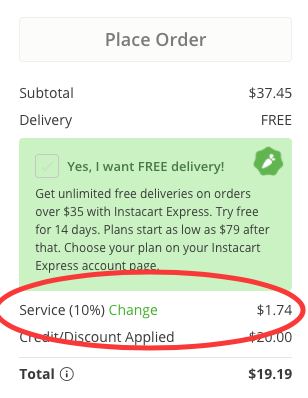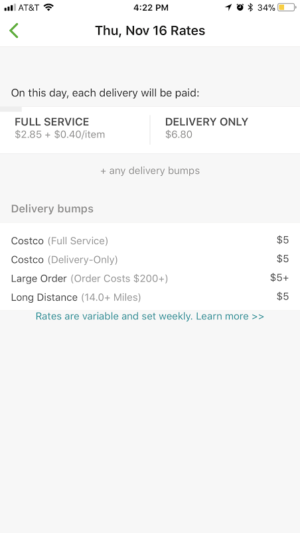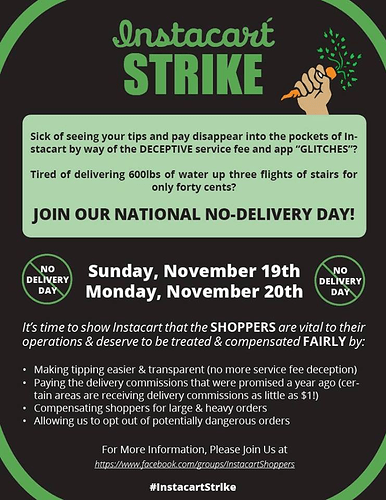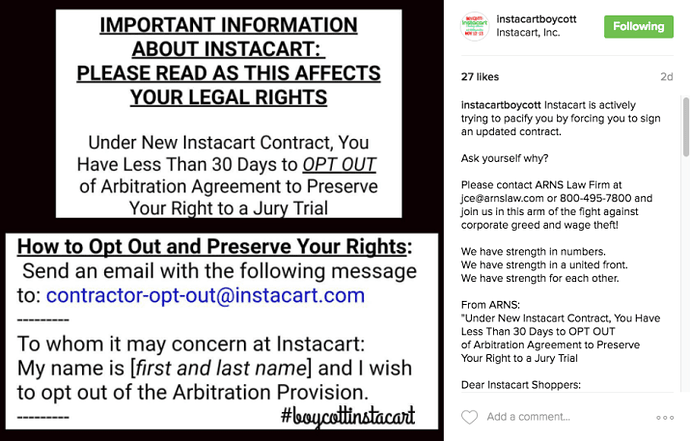It seems that Instacart is on a crash course with its shoppers and the courts. This delivery services giant has let greed overtake its common sense and changed the game plans on the ground in such a way that shoppers are now ganging up to strike as well as sue Instacart for severe underpayment.
Instacart raised over $675 million since 2013 from venture capital and the app and site that they developed enables customers to order groceries online. The customer creates a shopping list and then Instacart shoppers go and purchase the list and deliver it to the customer.
While the company has been sued much time since its inception, most cases by shoppers claiming inadequate wages, most of the lawsuits were settled with cash payments numbering several millions of dollars. While the shoppers represented in the suits will make a few hundred dollars each, the lawyer representing the case will make millions.
Instacart has over 300 employees that work out of its office in San Francisco. The company works on similar lines to Uber and Lyft. Instacart has a number of worker types, direct workers that are employed in their HQ and different types of shoppers. There are independent contractors, some itinerant shoppers, a few in-store shopper and contract deliver only workers. Instacart operates in 154 cities around the US.
When questioned, one of the Instacart shoppers requested to remain anonymous since he had a daytime job and didn't want any reprisals, stated that they are planning on refusing batch work the coming week. They will continue to refuse batch work until they are kicked off work for the rest of the day. The reason for the strike and activity is due to the recent changes in how Instacart pays its shoppers. The strike might be small or large, it is as yet unknown how far the reach of their grievance has covered through social networking, but on Sunday Instacart and customers will both find out and the group hopes to educate customers as well as Instacart about their grievances. One of the shopper preparing to strike stated that the reason they are taking this route is helping shoppers understand and not be afraid to stand up for themselves.
Instacart has not responded to questions about the strike and just told us to consider interviewing all kinds of employees and not just the disgruntled ones. They even offered a list of employees we should contact, although whether they are real employees or not is another issue. We contacted them, and they claimed they had no notion of a strike and didn't have any complaints against Instacart. One such employee was an in-house shopper, which is different from an independent contractor, these employees are paid a base income from the shop they work in, so it was no wonder he claimed to receive $20 per hour. He backed Instacart in every possible way stating that they were a solid company that took care of their employees.
However, to every cloud with a silver lining is a black cloud with thunder. The strike has a few leaders, one of them is Chicago based Mathew Telles, an independent contracting shopper, working for Instacart for two years. Telles is one of the plaintiffs in Camp et al. v. Maplebear dba Instacart case that has settled with a $4.6 million preliminary settlement of which Telles will get only $681.
Telles told us that there are a great number of "full-service shoppers" that perform a comprehensive service including direct communications via texting with customers as they shop, paying for the food, loading and delivering them. These three actions enable them to receive income from three separate activities; shopping, paying and delivering.
He went on to explain how the process works; first of all the commission paid is per delivery, and this is an algorithm. The algorithm is based on region, time of day and day of the week. There are extreme differences in commissions across the US, some like NY pay $14 and others like Evansville, Indiana that pay only $1. The amount drops according to saturation, where there are a full-service shopper and delivery contractor the mount drops. Another income factor is the pay per item fee that customers pay to the shoppers; it is set at $0.40 per item, this means if you buy one piece of gum or a box of 12 2-liter bottles of Soda, you get $0.40 for each one. As you can see, the downside is for heavy duty shopping, where you get the same income per item for lugging heavy loads from the shop to the customer. In many cases, this can include tens of cartons of heavy items upstairs, across long walkways and you end up getting paid the same as if you lugged three bags of potato chips.
This is felt exponentially by shoppers for big companies that order huge amounts and use Instacart's service since it is cheaper than a standard delivery service. The shopper/delivery agent gets to deliver what should be taken in a semi-trailer, in their small private car. When called in, the Instacart service replies that the agent must deliver or be deactivated.
The final form of income is from tips and service fees, these are two separate items, and have been at the root of all the current concern. Originally shoppers would get a tip from their customers, and when Instacart started to expand, they decided to play around with the payment methods and canceled tips, replacing them with a 10% service fee. This caused a lot of consternation since most shoppers would earn their main income through tips, now this was taken from them, and their income sometimes dropped by 90%!
Telles stated that when he earned tips his income was around $1,200 a week, then one bright and sunny day Instacart pulled clouds over this, and I started to earn for the same amount of work only $250. After a great sign of discontent by shoppers, Instacart recovered the tip part of the app but hid it so well that most customers had no idea that the service fee was not a tip and made sure that customers would remain confused. Many of the shoppers had to learn how to show their customers that the service fee was not a tip and taught them how to remove the service fee and replace it with a tip. The tip feature was placed in such an awkward place that there was no way anyone would consider looking for it and even finding it.
One California Instacart shopper stated that Instacart had to grow fast and the only way they could do that was to lower shopper payments. Today, when you add up the service fee, the per item fee and the commission you make less combined then single tip. In fact, this shopper stated that the income per mile, if calculated that way was not profitable, the opposite, we end up paying to work for Instacart and not the other way around.

One frustrated shopper Sheena Layne said that it was the first time she ever worked for a company that paid less the harder she worked. Layne started to work for Instacart in 2015 and was pulling in $1,000 per week for 30 hours work, now she works 60 hours and drives more miles and gets paid a third of the amount!
Layne added that in two years of working for Instacart she had accumulated over 100,000 miles on her car. She correctly grumbled that she did not know many people that would agree to deliver 40 cases of water for $5.
From information provided by shoppers, we see that Instacart pays less than minimum wage for many shoppers around the US, including a seven-hour shift that paid out only $16.95 in Jackson, Mississippi. In St. Louis Missouri one shopper earned only $13.30 for three hours, while in Austin Texas an all-time low of $2.80 was paid for a two-hour shift. In comparison, a common laborer with no formal education in the Philippines earns double than what was earned in Austin.

There is one large difference between the two shopper types in Instacart, and they accentuate the difference in income models. The part-time in-store employees receive a capped 29 hours a week. Their work is only to be a shopper; they are part-time employed by the local store they work in, while they do not receive health care from Instacart, they do work in an air-conditioned environment, and receive a $20 per hour for just shopping. This contrasts vastly from the remaining independent contractors that both shop and deliver or deliver only.
Nate D'Anna, CEO of a new gig economy analytics company called" Dumplings" stated that in most cases we could prove that Instacart shoppers are earning well below minimum wage. Our company was set up to provide transparency of information regarding income for gig economies. D'Anna decided that it was important to try out first hand the Instacart experience, so he worked for three hours as an Instacart shopper. His experience included delivering crates of water to Adobe HQ and double parking in crowded streets to meet delivery deadlines.
D'Anna went on to say that an anonymous shopper from Las Vegas reported delivering 600 pounds of sugar with cooking oil and was injured during the delivery process. When she tried to contact Instacart support, instead of receiving the help she was given a "Reliability Incident" status, which is an Instacart penalty and that can lead up to permanent deactivation.
Instacart is still in the process of dealing with 50 arbitration cases; these cases are a product of employment contracts with clauses that force independent contractors and employees to accept arbitration over class action lawsuits. Such private arbitration cases usually go the companies' way and not the employees, and in some instances, such as the $46 million case, the result is small change when compared to what a court ruling might have decided had it gone to court. The fact that Instacart is facing so many cases is also a wake sign for them since each case requires contracting a lawyer and each lawyer demands payment. The financials used to manage 50 cases is very high, and this might be a signal that the workers are unionizing and the lawyers creating joint strategies to cripple Instacart.
There remain two key questions that have not been answered by the arbitration cases, and these are; will the majority of Instacart shoppers remain independent contractors? And if so, will their income remain under the US minimum wage requirements? Until Instacart resolves this issue, there is room for other players to come in and take over. For instance, DoorDash and Postmates are both well-established gig companies that can adapt their app to include Instacart features, in fact, they are very similar in that they already enable their deliverers to purchase meals and goods from merchants using a company top-up debut card. Their payment models are different from Instacart's and have not caused any friction between the deliveries and the companies, which is proof that Instacart is a bad employer.
Another question that arises is one based on the above reports of independent contractors complaining about their income, nowhere does it state that anyone is forced to work for Instacart, if their payment model is so bad, stop working for them. Find an alternative solution; there are many gig companies out there that offer better income. A mass migration of disgruntled workers should be enough to collapse a bad gig. However, rather than leave, why not band together and sell your selves as a national product to another gig company, or even set up a gig company by banding together as a cooperative and supply your own version of Instacart.
The end result is what will happen after the strike, how far-reaching is its organization and will their impact be powerful enough to make their claims heard. Organizing a picket line, and creating a large enough strike force requires coordinated action on a massive scale. If the strike is successful, then the "union" leaders will be able to actually "unionize" in reality and have a very strong impact on how Instacart will face its future. If the strike fails, Instacart will have won hands down, and that will give them the strength to consolidate its position in regard to all future lawsuits and arbitration cases arising from the independent contractor sector.


